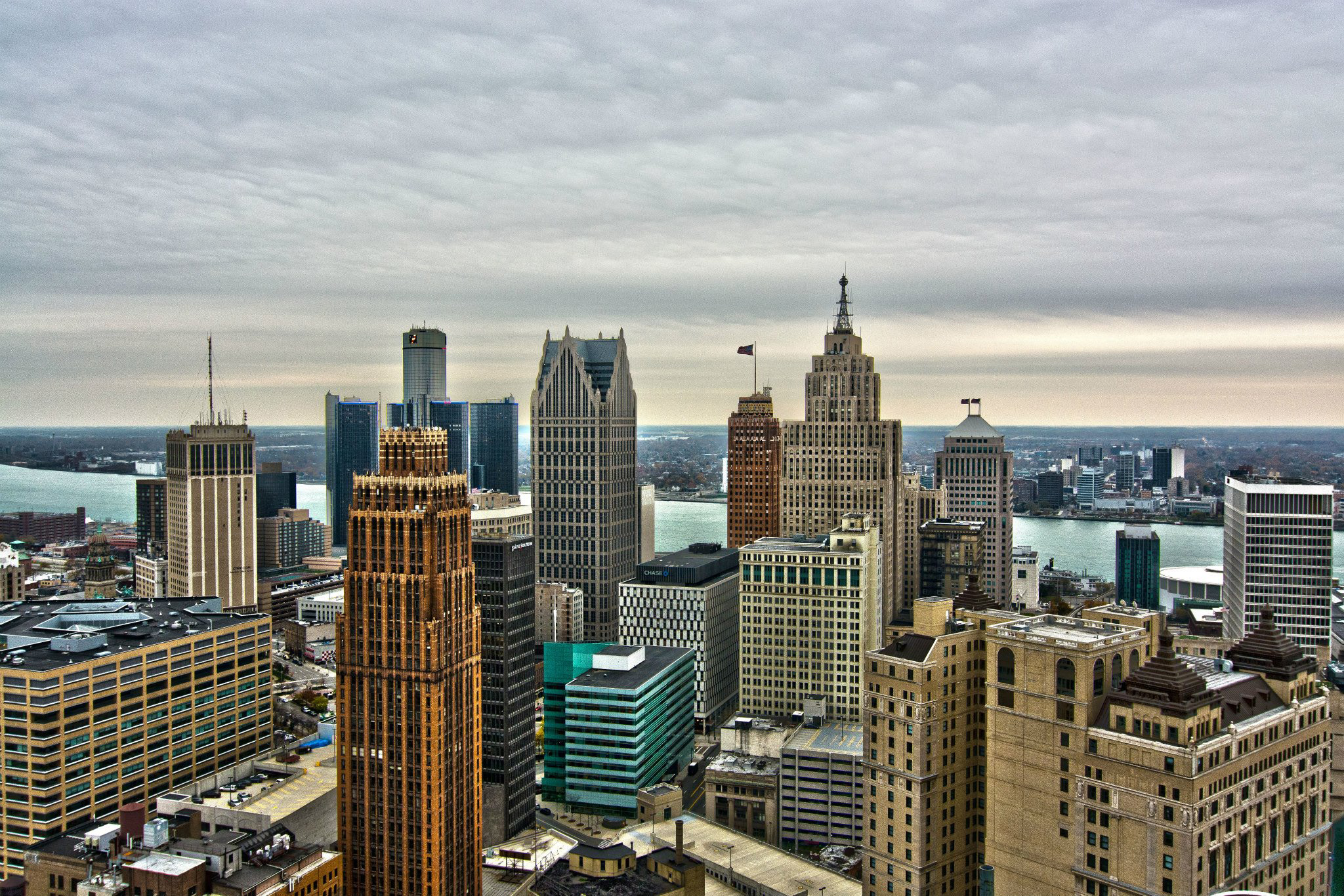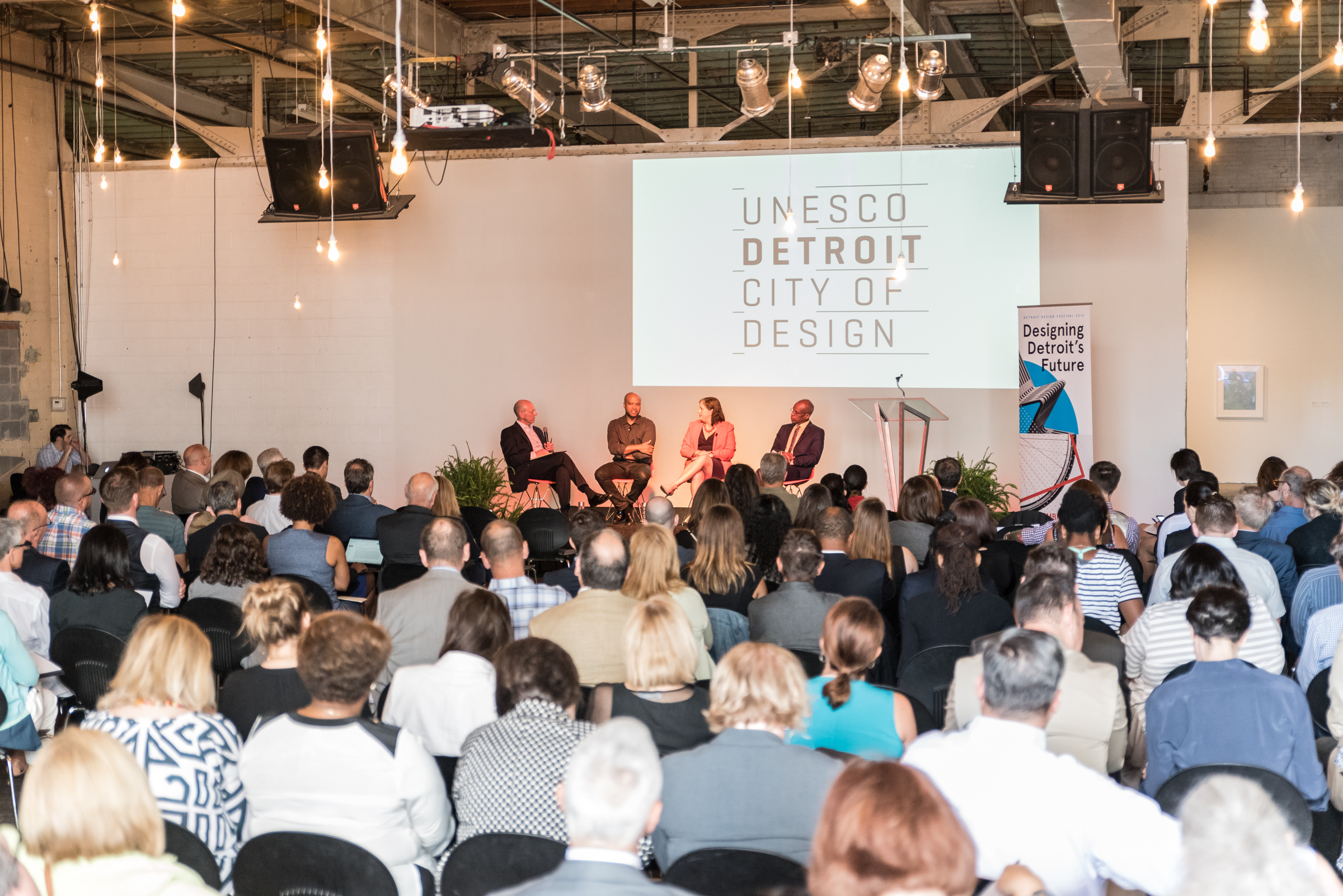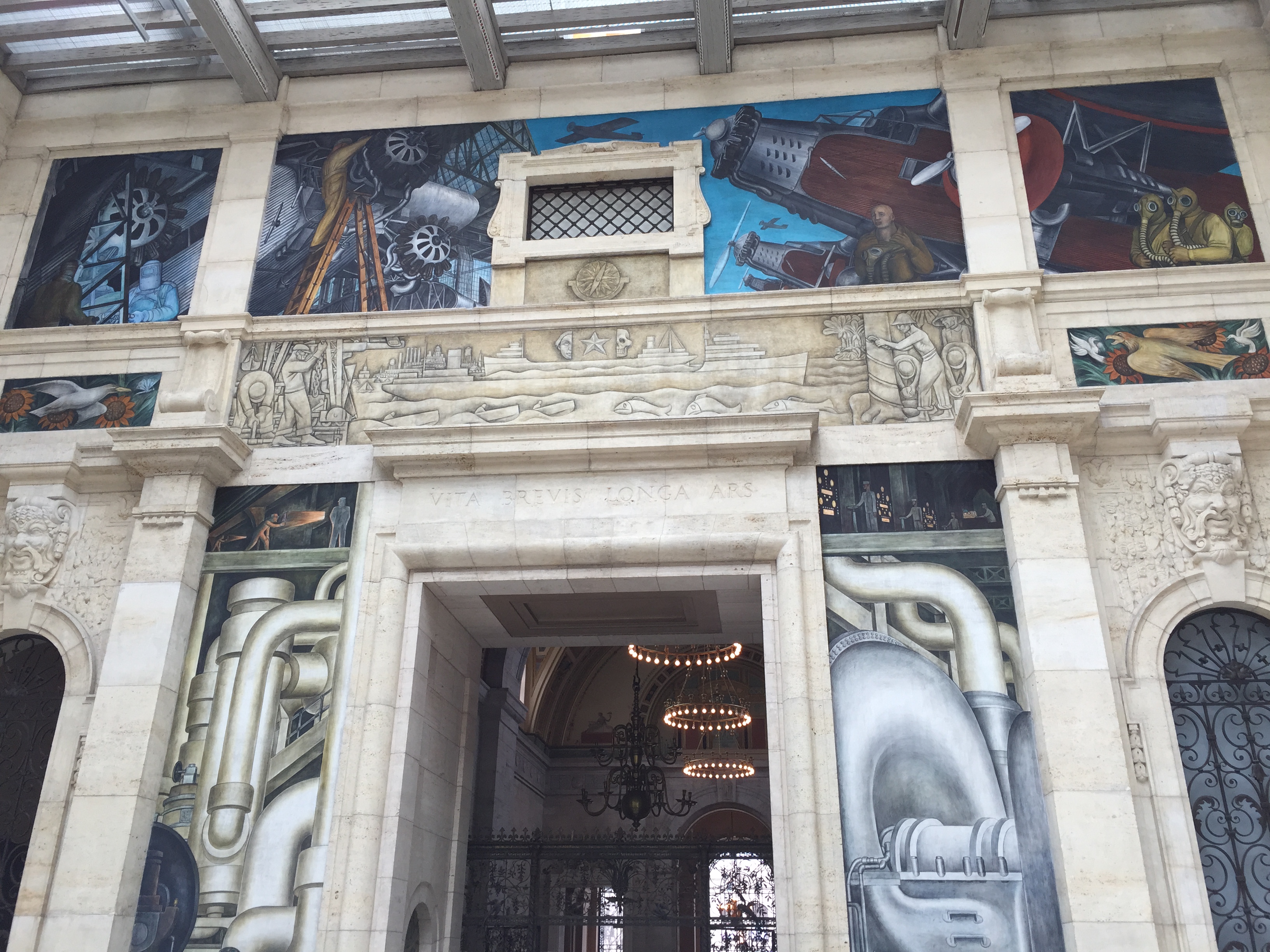
Detroit’s history as a center of design reinvigorates its renewal
Art Deco design figures prominently in the skyline of downtown Detroit. Photo by Anthony Barchock.
Detroit is the cradle of American design.
The region started as the place for cast iron stoves, railcars and bicycles at the turn of the 19th century, and then became the hotbed of the automobile, industrial design and midcentury modern furniture. That’s right: Eero Saarinen and Charles and Ray Eames, designers of such icons as the Tulip Chair and molded plywood lounge chair, met at Cranbrook Academy of Art in the suburbs of Detroit.
“This isn’t a backwater that we just decided to be a design capital,” said Olga Stella, executive director of the Detroit Creative Corridor Center (DC3), an accelerator and advocate for Detroit’s creative economy. “From the beginning, we’ve influenced the future choices of people around the world.”
And design is about to influence the future of Detroit.
Stella and other cultural, political and business leaders believe that design can improve the lives of the city’s residents. They look at design not as an aesthetic or a luxury good, but as the foundation of how things work. It’s about how bus routes function and whether streets feel walkable. It’s whether you get lost in a hospital because the signage is poorly designed. It’s about how and when we consume information. They see design and designers present in every aspect of urban life.
“I look at design as a basic democratic right as a citizen of a democracy,” said Maurice Cox, the city of Detroit’s new planning director and former head of design for the National Endowment for the Arts. “It’s no different than a right to a quality education.”
The United Nations agrees: Last December the United Nations Educational, Scientific and Cultural Organization (UNESCO) named Detroit the country’s very first City of Design and inaugurated it into the Creative Cities Network. UNESCO formed the network in 2004 and so far has added 116 cities in celebration of their excellence and legacy in one of seven creative areas: crafts and folk art, design, film, gastronomy, literature, music and media arts. In the United States, just four cities other than Detroit have been honored: Tucson, Arizona (gastronomy); Santa Fe, New Mexico (crafts and folk art); Iowa City, Iowa (literature); and Paducah, Kentucky (crafts and folk art).

“Designing Detroit’s Future” event 2016.
The news of Detroit’s design designation caught people by surprise, as the city was fresh out of bankruptcy court and known more for its blight and poverty than the great architecture that dots the downtown skyline, such as the Guardian Building. Surely, UNESCO meant New York, Los Angeles or even New Orleans?
“There is this strong design community here, but I don’t know that the mass public understands that it exists,” said Stella, whose organization applied for the UNESCO award.
“This is not a prize,” she added. “We did not receive this for reaching the pinnacle. This is a call to action. If this is just something we put on our marketing material, it’s not much good to us.”
In June, DC3 heeded the call and began a 10-year initiative to consider how the designation can be used to help Detroit rebuild its infrastructure and legacy. Fellow design cities are already seeing concrete results from their inclusion in the network: The number of design firms based in Berlin has jumped more than 25 percent since it joined the network in 2005; and Montreal has hosted 25 public design competitions since 2009, netting $17 million in revenue for the local design industry.
“When people look back at what we do, I hope that they will say that Detroit was very creative and very clever in using the City of Design designation to advance larger goals for the city,” said Richard Rogers, the president of the College for Creative Studies, which co-founded DC3. “Improving the quality of life for all the residents, revitalizing the neighborhoods, generating jobs.”
Already DC3 has helped 200 businesses either start up or grow over the past six years, creating 2,500 new jobs. And 1,000 people RSVP – and 500 show up – for its monthly design cocktail parties. Each September it hosts the Detroit Design Festival, which brings in a global audience. Stella expects that to be even more robust this year thanks to the UNESCO affirmation. Already fellow design city Saint-Etienne, France, announced it would spotlight Detroit in its 2017 international design biennale.
Early discussions about the 10-year initiative are focused on community engagement through a public awareness campaign, a new member network for designers, and events such as the monthly Drinks X Design happy hours and the Detroit Design Festival. But Rogers is adamant that the results will be more than just “a frothy add-on” and that “real substance will come out of this work.”
That is where Cox and City Hall are critical. They can take the conversations to the streets.

Detail of Diego Rivera Detroit Industry murals at the Detroit Institute of Arts. Photo by Michael Bolden.
As the city rebuilds its infrastructure post bankruptcy – it just demolished its 10,000th blighted home since 2014 and plans to have the streetlight grid completely functioning by the end of the year – officials are thinking about how to best harness the once-in-a-lifetime opportunity.
Cox is engaging in 100-year thinking rather than “good enough” thinking that has long plagued Detroit. He is working on a citywide master plan that brings the city’s neighborhoods to the forefront of the conversation. Because while Detroit is becoming well known for a burgeoning restaurant scene and thriving business district in the greater downtown area, most of the city’s 139 square miles are made up of neighborhoods still reeling from decades of disinvestment and declining population.
Cox believes the antidote to that is design. Design is part of the zoning code and rebuilding commercial corridors and making districts walkable. Design will help determine where new housing and where new density gets built – and what it looks like. Design will be a part of rethinking Detroit’s vast tracks of empty land and how to beautify them, develop recreation areas and turn others into green infrastructure projects, such as wetlands that can filter rain water runoff.
“It’s important as we open up opportunity for neighborhood development that the design of that development be exemplary, be inspired,” he said. “Detroit is returning to its grand tradition of neighborhood building. Detroiters are a very neighborhood crowd. We want them to be proud of the new things that are built in their neighborhoods.”
That means, Cox said, developers are on notice that they will have to do things differently in Detroit. The planning department will be considering context and design, not just whether a project meets code. But first Cox is concentrating on finishing the city’s master plan and having it be more than a land use guide that sits in a drawer, as so many have in the past. He is also rebuilding a planning department that was gutted by decades of shrinking budgets, shifting priorities and politics.
“Detroit is rebuilding and much that will last forever,” said Katy Locker, Detroit program director for Knight Foundation, which has invested $500,000 in DC3. “If you look at how much damage can be done by bad design, and what is being invested, we have to ask, ‘What will our legacy be?’ I want a legacy like the Guardian Building and Belle Isle.”

An exterior view of the Belle Isle Aquarium. Photo by Anthony Barchock.
One element stalling Detroit’s efforts to be a great design city of the future – not just of the past – is corporate engagement. Minneapolis-based Target Corp., for example, prioritizes hiring local design talent, said Tim Smith, CEO and owner of Detroit design firm Skidmore Studio. To him, it would be critical for the Detroit design community to enjoy the same corporate support that the Minneapolis design community enjoys.
“We have the building blocks and the gumption, but we don’t have the corporate buy in yet,” he said. “We have the talent in spades.”
It was a huge coup, he said, when the Detroit Institute of Arts hired Patrick Thompson, a then-unknown local designer incubating with DC3, to reenvision the museum’s Kresge Court into the city’s “cultural living room.” Thompson’s business has since taken off, and he’s opened his own design studio in the city.
Patrick Thompson Design is just one of the dozens of creative firms that Smith has seen open since he relocated Skidmore to Detroit from the suburbs five years ago. Large ad agencies such as Campbell Ewald have moved downtown, joined by new businesses such as The Work Inc. and Detroit Lives. There are now more than 1,100 workers in greater downtown who are employed in the design community, which encompasses everything from retail to research and development, to film, graphic design, fashion and more.
“I had the paramount belief that Detroit’s recovery would be based on the creative community,” Smith said. “I couldn’t be a hypocrite and talk and not do, so I moved here.”
To Stella, that is just one more piece of evidence that design is Detroit’s future. But she wants to ensure that it is more than just a business development tool. She wants design to change how the city functions because, for her, it is about making life work, not just making pretty things.
“One of the things that could be unique about Detroit is really thinking about how we put people truly at the center of design and the center of solutions,” she said. “What could that look like? Could our city government be known as the most cutting edge and progressive from a planning and infrastructure and city service perspective?”
Amy Haimerl is a Detroit-based author and journalist. Learn more at amyhaimerl.com, and follow her on Twitter@haimerlad.
Recent Content
-
Community Impactarticle ·
-
Community Impactarticle ·
-
Community Impactarticle ·


